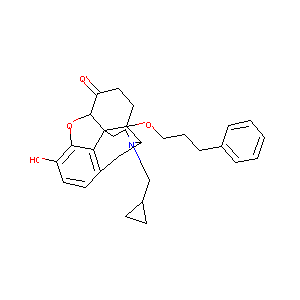Drug Information
| Drug General Information | Top | |||
|---|---|---|---|---|
| Drug ID |
D0E6GH
|
|||
| Former ID |
DNC009670
|
|||
| Drug Name |
14-O-phenylpropylnaltrexone
|
|||
| Synonyms |
14-O-phenylpropylnaltrexone; CHEMBL514774; SCHEMBL3167650; BDBM50249017
Click to Show/Hide
|
|||
| Drug Type |
Small molecular drug
|
|||
| Indication | Discovery agent [ICD-11: N.A.] | Investigative | [1] | |
| Structure |
 |
Download2D MOL |
||
| Formula |
C29H33NO4
|
|||
| Canonical SMILES |
C1CC1CN2CCC34C5C(=O)CCC3(C2CC6=C4C(=C(C=C6)O)O5)OCCCC7=CC=CC=C7
|
|||
| InChI |
1S/C29H33NO4/c31-22-11-10-21-17-24-29(33-16-4-7-19-5-2-1-3-6-19)13-12-23(32)27-28(29,25(21)26(22)34-27)14-15-30(24)18-20-8-9-20/h1-3,5-6,10-11,20,24,27,31H,4,7-9,12-18H2/t24-,27+,28+,29-/m1/s1
|
|||
| InChIKey |
KOXWKZKLXNZQAO-ZLPBPMGLSA-N
|
|||
| PubChem Compound ID | ||||
| Target and Pathway | Top | |||
|---|---|---|---|---|
| Target(s) | Opioid receptor delta (OPRD1) | Target Info | Inhibitor | [1] |
| Opioid receptor kappa (OPRK1) | Target Info | Inhibitor | [1] | |
| Opioid receptor mu (MOP) | Target Info | Inhibitor | [1] | |
| KEGG Pathway | Neuroactive ligand-receptor interaction | |||
| Estrogen signaling pathway | ||||
| Morphine addiction | ||||
| cGMP-PKG signaling pathway | ||||
| Sphingolipid signaling pathway | ||||
| NetPath Pathway | TCR Signaling Pathway | |||
| Panther Pathway | Heterotrimeric G-protein signaling pathway-Gi alpha and Gs alpha mediated pathway | |||
| Heterotrimeric G-protein signaling pathway-Gq alpha and Go alpha mediated pathway | ||||
| Enkephalin release | ||||
| Opioid proenkephalin pathway | ||||
| Opioid proopiomelanocortin pathway | ||||
| Opioid prodynorphin pathway | ||||
| Pathway Interaction Database | IL4-mediated signaling events | |||
| Reactome | Peptide ligand-binding receptors | |||
| G alpha (i) signalling events | ||||
| WikiPathways | TCR Signaling Pathway | |||
| GPCRs, Class A Rhodopsin-like | ||||
| Peptide GPCRs | ||||
| Opioid Signalling | ||||
| GPCR ligand binding | ||||
| GPCR downstream signaling | ||||
| References | Top | |||
|---|---|---|---|---|
| REF 1 | 14 beta-O-cinnamoylnaltrexone and related dihydrocodeinones are mu opioid receptor partial agonists with predominant antagonist activity. J Med Chem. 2009 Mar 26;52(6):1553-7. | |||
If You Find Any Error in Data or Bug in Web Service, Please Kindly Report It to Dr. Zhou and Dr. Zhang.

